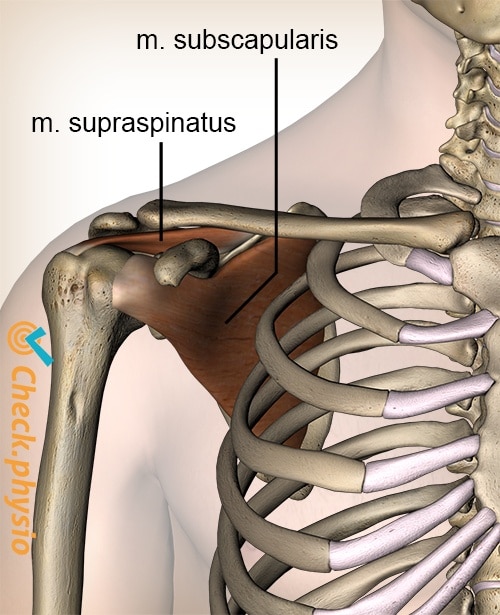Subscapularis tendinopathy
Subscapularis tendinitis / subscapularis tendinosis / subscapularis tear
The subscapularis is one of the four rotator cuff muscles that work together to control the movements of the shoulder whilst ensuring that the head of the humerus does not move too far out of the socket. The subscapularis is the largest and strongest of the four muscles. Its main function is to rotate the upper arm inwards. A subscapularis tendinopathy means that the tendon of the muscle is affected.

The condition produces symptoms along the front of the shoulder or in the armpit.
Description of the condition
The subscapularis tendinopathy is usually caused by an inflamed subscapularis tendon (tendinitis) or degeneration of the tendon (tendinosis). The tendon is located along the front of the shoulder and attaches to the head of the humerus. When an affected subscapularis is contracted or stretched, this can produce symptoms as a result of tractive forces acting on the muscle or tendon. In some cases, a partial or complete rupture of the subscapularis tendon can occur.
Subscapularis injury can result in impingement syndrome, with the head of the humerus becoming impinged under the roof of the shoulder structure.
Cause and origin
Symptoms can occur as a result of overloading, incorrect use or degeneration of the tendon. A complete muscle or tendon rupture is only seen after an accident or fall and is more common in older patients.
Signs & symptoms
The patient will complain about pain along the front of the shoulder (or in the armpit) and will struggle to lift objects in front of the chest. Movements that require inward rotation of the upper arm (inward rotation) will also result in symptoms. For example, the patient will struggle to place his hand on his back and then move the hand away from the back from this position. External rotation (outward rotation) of the upper arm can also produce pain symptoms in the final position, because the muscle and tendon are completely extended in this position.
Diagnosis
The diagnosis is made following a number of physiotherapeutic tests. It is hard to distinguish between tendinosis and tendinitis. In some cases an ultrasound examination or MRI scan can be considered to image the subscapularis structures.
Treatment
Most cases will involve tendinosis. This can be treated with eccentric strength exercises. Anti-inflammatory medication can be used for cases of tendinitis. Surgical stitching can be considered in the case of a rupture. This is often not useful for older patients, as the risk of relapse following a rupture is too high.
Exercises
Take a look at the carefully prepared exercise programme here with exercises for subscapularis tendinopathy.
You can check your symptoms using the online physiotherapy check or make an appointment with a physiotherapy practice in your area.
References
Cleland, J.A. & Koppenhaver, S. (2011). Netter's orthopaedic clinical examination: an evidence-based approach. 2nd ed. Philadelphia: Saunders Elsevier.
Longo, U.G., Berton, A., Marinozzi, A., Maffulli, N. & Denaro V. (2012). Subscapularis tears. Med Sport Sci. 2012;57:114-21.
Nugteren, K. van & Winkel, D. (2007). Onderzoek en behandeling van de schouder. Houten: Bohn Stafleu van Loghum.


